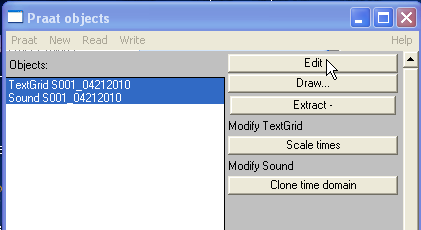

Wav aif converter.praat A simple, but very useful script for those who wish to share soundfiles between Macs and PCs. Bits of this script show up in all of my larger scripts that have the word "measure" in their filename. It allows you to make edits and saves the changes before moving to the next textgrid.ĭuration logger.praat Useful for measuring the length of intervals marked in a textgrid.

This script makes the reviewing process easy. Text grid reviewer.praat Once you (or a research assistant) have created textgrids, it can be useful to open each sound file and its corresponding textgrid to review the boudnaries and annotations that have been created. Very useful for creating textgrids once a recording has been completed. Text grid maker.praat My first ever Praat script.
#LARGE AMOUNT OF SOUND FILES ON PRAAT FREE#
Please feel free to download, modify, and redistribute the scripts without restriction. Each script may be downloaded by clicking on the name. I have omitted some scripts that are very similar to those posted here, or some of the larger scripts that have been tailored to a particular set of stimuli. I receive frequent requests along the lines of, "Do you have a script that does x?"Įvery Praat script that I have is listed below, along with a brief description. Below, I have listed all of the Praat scripts that I have in my possession. Bits and pieces can be reused from other scripts, and in this way new scripts can be generated very quickly.
#LARGE AMOUNT OF SOUND FILES ON PRAAT CODE#
However, I rarely code a script from scratch. This way, when the time comes to write up the Method section, all of the information is easily accessible and traceable.ĭue to this new project-based scripting technique, I create a new script for each project that I am working on. Now, for each project, I create one large Praat script that contains all manipulations: taking original measurements, manipulating intensity, pitch, ramping, etc., renaming files, and taking new measurements after all manipulations have been completed. As a result, a few years ago, I changed the way that I used Praat scripts. What I found was that the problem with such an approach is that it is very easy to lose track of what manipulations you have already done to a set of sound files - especially if you are working on multiple projects at the same time, with different normalisation scripts, etc. For instance, after a recording session, I would use one script to cut the large file of the entire recording session into smaller files, a separate script to extract measurements, another script to normalise the intensity of the sounds, and yet another script to ramp in and out, and so on. When I first started using Praat, I used many small scripts, each of which performed one small job. I cannot stress this enough: you have to know exactly what the script is doing. But be warned, a script cannot do anything that requires human judgment, such as labeling segments. As I have mentioned before, Praat scripts can take care of many repetitive actions for you, saving you many mouse clicks.


 0 kommentar(er)
0 kommentar(er)
